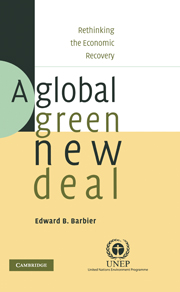Book contents
- Frontmatter
- Contents
- List of figures
- List of tables
- List of boxes
- Foreword
- Preface
- Acknowledgements
- Part I Why a Global Green New Deal?
- Part II The Key Components of a Global Green New Deal
- Part III The Role of the International Community
- Part IV Towards a Greener World Economy
- Appendix 1 PIIE–WRI analysis of a green recovery program for the United States
- Appendix 2 Pew comparative analysis of clean energy jobs and investments in the United States, 1998–2007
- Glossary
- Index
Appendix 2 - Pew comparative analysis of clean energy jobs and investments in the United States, 1998–2007
Published online by Cambridge University Press: 05 June 2012
- Frontmatter
- Contents
- List of figures
- List of tables
- List of boxes
- Foreword
- Preface
- Acknowledgements
- Part I Why a Global Green New Deal?
- Part II The Key Components of a Global Green New Deal
- Part III The Role of the International Community
- Part IV Towards a Greener World Economy
- Appendix 1 PIIE–WRI analysis of a green recovery program for the United States
- Appendix 2 Pew comparative analysis of clean energy jobs and investments in the United States, 1998–2007
- Glossary
- Index
Summary
A report by the Pew Charitable Trusts compares the job growth and investments in the clean energy sector of the US economy to the rest of the economy for the ten years leading up to the current recession, 1998 to 2007.
The Pew study defines the US clean economy as the sector that “generates jobs, businesses and investments while expanding clean energy production, increasing energy efficiency, reducing greenhouse gas emissions, waste and pollution, and conserving water and other natural resources.” The five economic activities comprising the clean economy are as follows.
Clean energy production: jobs, businesses and investments that produce, transmit and store renewable energy from solar, wind, low-impact hydropower, hydrogen fuel cells, marine and tidal, geothermal and small-scale biopower energy sources.
Energy efficiency: jobs, businesses and investments that reduce the amount of energy used in the economy.
Environmentally friendly production: jobs, businesses and investments that mitigate the harmful environmental impacts of existing products and develop and supply alternatives that require less energy and emit fewer greenhouse gases.
Conservation and pollution mitigation: jobs, businesses and investments that manage water and other finite natural resources more effectively, mitigating emissions of greenhouse gases and other pollutants that result from the continued use of fossil fuels.
Training and support: jobs, businesses and investments that provide specialized services to the other four areas of the clean energy economy.
The Pew report finds that, between 1998 and 2007, jobs in these five clean energy areas grew more rapidly than overall job growth in the United States.
- Type
- Chapter
- Information
- A Global Green New DealRethinking the Economic Recovery, pp. 287 - 292Publisher: Cambridge University PressPrint publication year: 2010



